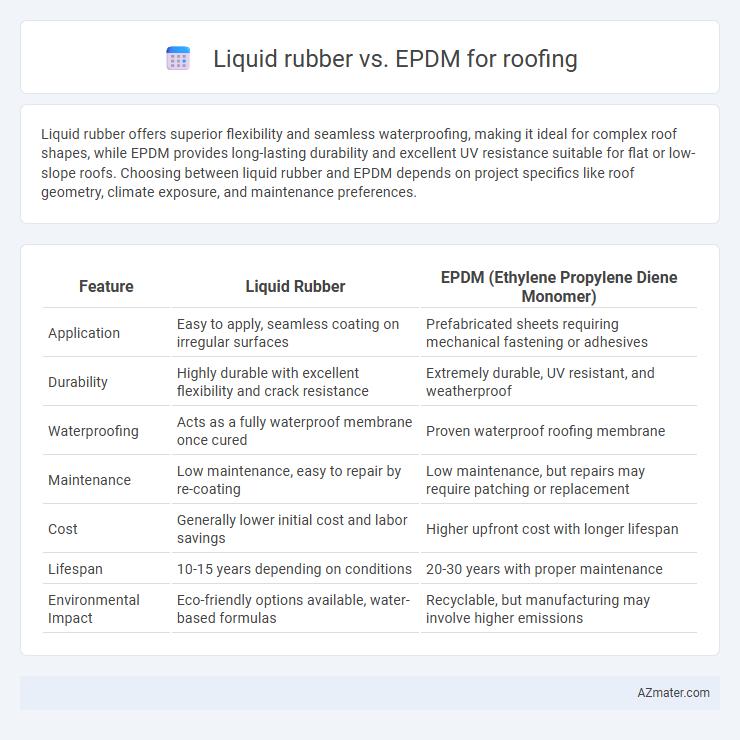Liquid rubber offers superior flexibility and seamless waterproofing, making it ideal for complex roof shapes, while EPDM provides long-lasting durability and excellent UV resistance suitable for flat or low-slope roofs. Choosing between liquid rubber and EPDM depends on project specifics like roof geometry, climate exposure, and maintenance preferences.
Table of Comparison
| Feature | Liquid Rubber | EPDM (Ethylene Propylene Diene Monomer) |
|---|---|---|
| Application | Easy to apply, seamless coating on irregular surfaces | Prefabricated sheets requiring mechanical fastening or adhesives |
| Durability | Highly durable with excellent flexibility and crack resistance | Extremely durable, UV resistant, and weatherproof |
| Waterproofing | Acts as a fully waterproof membrane once cured | Proven waterproof roofing membrane |
| Maintenance | Low maintenance, easy to repair by re-coating | Low maintenance, but repairs may require patching or replacement |
| Cost | Generally lower initial cost and labor savings | Higher upfront cost with longer lifespan |
| Lifespan | 10-15 years depending on conditions | 20-30 years with proper maintenance |
| Environmental Impact | Eco-friendly options available, water-based formulas | Recyclable, but manufacturing may involve higher emissions |
Introduction to Liquid Rubber and EPDM Roofing
Liquid rubber roofing consists of a highly flexible, seamless coating applied as a liquid that cures into a durable, waterproof membrane, ideal for complex roof shapes and quick application. EPDM (ethylene propylene diene monomer) roofing is a synthetic rubber membrane known for its exceptional resistance to UV radiation, ozone, and extreme weather, widely used in commercial and residential flat roofs. Both materials provide long-lasting protection, with liquid rubber offering superior flexibility and EPDM excelling in proven durability and ease of maintenance.
Material Composition and Properties
Liquid rubber roofing is primarily composed of synthetic polymers like acrylics or polyurethanes that cure to form a seamless, flexible membrane resistant to UV rays, water, and temperature fluctuations. EPDM (ethylene propylene diene monomer) is a vulcanized synthetic rubber known for its excellent elasticity, weather resistance, and durability in extreme temperatures, typically supplied as pre-formed sheets. Both materials offer superior waterproofing, but liquid rubber excels in seamless application and adaptability to irregular surfaces, whereas EPDM provides proven long-term resistance with high tensile strength and puncture resistance.
Installation Process Comparison
Liquid rubber offers a seamless application through roller or spray methods, allowing for quick coverage over complex roof contours without joints. EPDM requires precise prefabricated membrane installation, involving adhesive application and careful seaming to ensure watertight integrity. Liquid rubber's faster cure time reduces labor hours compared to the more labor-intensive, multi-step EPDM installation process.
Durability and Longevity
Liquid rubber roofing offers exceptional flexibility and seamless application, which enhances its ability to withstand extreme weather conditions and temperature fluctuations without cracking. EPDM (ethylene propylene diene monomer) is renowned for its resistance to UV rays, ozone, and chemical exposure, providing superior durability over time, often lasting 20-30 years with minimal maintenance. Both materials deliver strong longevity, but liquid rubber's self-healing properties and easy reapplication can extend roof life beyond traditional EPDM membranes.
Waterproofing Performance
Liquid rubber offers exceptional waterproofing performance by forming a seamless, flexible membrane that adapts to roof movements and eliminates leak-prone joints. EPDM (ethylene propylene diene monomer) also provides strong waterproofing with high resistance to UV rays and weathering, maintaining durability over decades. While EPDM is highly effective for static installations, liquid rubber excels in complex shapes and repairs due to its superior flexibility and adhesion.
UV and Weather Resistance
Liquid rubber offers exceptional UV resistance with a flexible coating that prevents cracking and peeling under harsh sunlight. EPDM roofing boasts superior weather resistance, maintaining durability through extreme temperatures and heavy rain, thanks to its synthetic rubber composition. Both materials exhibit strong resilience, but liquid rubber's seamless application enhances protection against UV rays more effectively than EPDM membranes.
Maintenance Requirements
Liquid rubber roofing requires minimal maintenance due to its seamless application that prevents cracks and leaks, reducing the need for frequent repairs. EPDM roofing, while durable, often necessitates regular inspection for seam integrity and potential punctures that could lead to water infiltration. Both materials benefit from periodic cleaning, but liquid rubber's flexible membrane typically demands less upkeep over time compared to EPDM's more maintenance-intensive joints and patches.
Environmental Impact and Sustainability
Liquid rubber roofing membranes offer excellent environmental benefits due to their low VOC emissions, recyclability, and ability to extend roof life, reducing landfill waste. EPDM roofing is highly durable and energy-efficient, reflecting sunlight to reduce cooling costs, with a notable lifespan that minimizes the frequency of roof replacements. Both materials support sustainable roofing practices, but liquid rubber's seamless application often results in fewer leaks and less material waste during installation.
Cost Comparison and Value
Liquid rubber roofing typically offers a lower initial cost compared to EPDM, making it a budget-friendly option for short-term projects or smaller areas. EPDM roofing, though more expensive upfront, provides superior durability and longer lifespan, resulting in better long-term value with fewer maintenance requirements. Considering the total cost of ownership, EPDM often delivers greater cost efficiency due to its resistance to weathering, UV exposure, and mechanical damage.
Which Roofing Solution Is Best?
Liquid rubber roofing offers superior flexibility and seamless application, making it ideal for complex roof shapes and preventing leaks effectively. EPDM roofing provides exceptional durability and resistance to UV rays and weathering, often lasting 20-30 years with minimal maintenance. Choosing between liquid rubber and EPDM depends on budget constraints, roof configuration, and long-term performance requirements, with EPDM favored for durability and liquid rubber preferred for ease of application and waterproofing.

Infographic: Liquid rubber vs EPDM for Roofing
 azmater.com
azmater.com